Make a suit of chain-mail armor
 Two leather-clad warriors face each other, swords drawn. Suddenly one of the warriors attacks, his swinging sword clanging loudly against the defending warrior’s. Back and forth they cut and parry, the meadow ringing from impacts. Suddenly the attacker sees an opening and takes a swing he knows will surely cut his opponent in two. His sword slices through his enemy’s leather clothing—but strikes metal instead of flesh! Stunned but far from dead, the attacked warrior says a silent prayer of thanks to the armorer who had saved his life by making him a coat of chain mail.
Two leather-clad warriors face each other, swords drawn. Suddenly one of the warriors attacks, his swinging sword clanging loudly against the defending warrior’s. Back and forth they cut and parry, the meadow ringing from impacts. Suddenly the attacker sees an opening and takes a swing he knows will surely cut his opponent in two. His sword slices through his enemy’s leather clothing—but strikes metal instead of flesh! Stunned but far from dead, the attacked warrior says a silent prayer of thanks to the armorer who had saved his life by making him a coat of chain mail.
The Scouts in BSA Troop 324 at European Command Headquarters in Stuttgart, Germany, don’t plan on being in any sword fights. But making their own suit of chain-mail armor can transport them to the days of shining knights, if only for one fun afternoon. Here’s how you can join them.
You’ll Need:
• two 500-foot rolls of 14-gauge copper wire
• electric drill with 3⁄4-inch bit and 1⁄8-inch bit
• wire cutters
• hammer and nails (long enough to secure wood together)
• wood saw
• wood glue
• 3-foot-long wooden dowel, 3⁄4-inch in diameter
• 7 feet of lumber
• adult’s help and/or permission
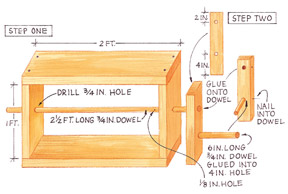 STEP ONE: Build a Wooden Rack
STEP ONE: Build a Wooden Rack
A rack or frame will make it easier to produce the many rings needed in a shirt of chain mail.
1. Cut the lumber into three 1-foot-long pieces and two 2-foot-long pieces. Set one 1-foot piece aside.
2. Through the center of two 1-foot pieces, drill a 3⁄4-inch hole. Move the drill bit around to make the holes slightly larger, so the 3⁄4-inch dowel easily slides through.
3. Build the rectangular rack with the two 2-foot pieces and two 1-foot pieces with holes.
4. Slide the dowel through both holes.
STEP TWO: Add a Crank
1. Cut 6 inches off the wooden dowel.
2. Drill two 3⁄4-inch holes into the 1-foot piece of lumber set aside in Step One. Drill the first hole about 2 inches from one end, the other hole about 4 inches from the other end.
3. Take the longer dowel piece and glue into the hole drilled 2 inches from one end.
4. Take the 6-inch dowel piece and glue it into the hole drilled 4 inches from the end, on the opposite side of the lumber. This will be your crank handle.
5. Insert the crank fully into the rack. It should turn easily. About 1 inch from the inside edge of the rack, drill a 1⁄8-inch hole through the center of the dowel.
6. Set aside to let glue dry.
STEP THREE: Ring, Ring, Ring
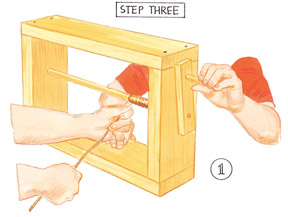 1. Insert one end of the wire into the hole in the dowel and begin turning the crank. Keep turning until the entire length of the dowel has a single layer of tight wire coil. Cut the wire from the roll.
1. Insert one end of the wire into the hole in the dowel and begin turning the crank. Keep turning until the entire length of the dowel has a single layer of tight wire coil. Cut the wire from the roll.
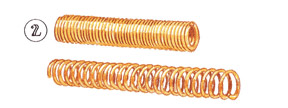 2. Cut the piece of wire that was inserted into the hole to begin the coil. Now you should be able to slide out the crank from the coil and the rack, leaving you with a coil of wire. Slightly stretch the coil.
2. Cut the piece of wire that was inserted into the hole to begin the coil. Now you should be able to slide out the crank from the coil and the rack, leaving you with a coil of wire. Slightly stretch the coil.
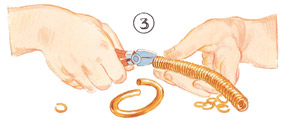 3. Cut the rings from the coil. This should leave you a pile of rings that are just barely open. Make more coils and cut more rings.
3. Cut the rings from the coil. This should leave you a pile of rings that are just barely open. Make more coils and cut more rings.
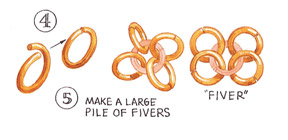 4. Take 4 rings and twist the 2 ends together to make a closed ring. Put these 4 solid rings onto a fifth ring and close this fifth ring so you have a group of 5, four rings on one. This “fiver” is the basic building block for the chain mail armor.
4. Take 4 rings and twist the 2 ends together to make a closed ring. Put these 4 solid rings onto a fifth ring and close this fifth ring so you have a group of 5, four rings on one. This “fiver” is the basic building block for the chain mail armor.
5. Make a large pile of fivers. Also keep a large group of slightly open single rings. When you have a good pile of each, it’s time to begin building the armor.
STEP FOUR: Knitting the Shirt
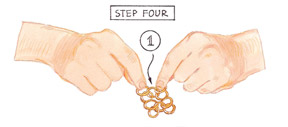 1. Take a fiver and lay it flat, moving 2 rings to the top of the center ring and 2 rings to the bottom. Do the same with another fiver and position it below the first fiver.
1. Take a fiver and lay it flat, moving 2 rings to the top of the center ring and 2 rings to the bottom. Do the same with another fiver and position it below the first fiver.
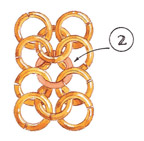 2. Take a single open ring and link the bottom 2 rings of the top fiver to the bottom 2 rings of the bottom fiver. This single ring now links 4 other rings, just like the fivers you have already made. Close this open ring. Even at this early point the rings should
2. Take a single open ring and link the bottom 2 rings of the top fiver to the bottom 2 rings of the bottom fiver. This single ring now links 4 other rings, just like the fivers you have already made. Close this open ring. Even at this early point the rings should
show a pattern, tilted up and tilted down as they rest upon each other. Add 2 more fivers to form a strip of four fivers. Make another strip of 4 fivers.
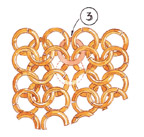 3. Lay a fiver strip flat to the right side of the first fiver strip. Take a single open ring to link the right 2 rings of the top left hand fiver in the strip to the left 2 rings of the top fiver in the right-hand strip. Continue to link the fivers as shown.
3. Lay a fiver strip flat to the right side of the first fiver strip. Take a single open ring to link the right 2 rings of the top left hand fiver in the strip to the left 2 rings of the top fiver in the right-hand strip. Continue to link the fivers as shown.
4. Hold up the linked fabric. You can “scrunch” the fabric easily in only one direction. Continue to build a large rectangular fabric. The direction of “scrunchiness” goes about the waist.
5. Once the fabric can comfortably circle your torso, with some slack, attach the 2 edges to form a cylinder.
6. Make two strips, at least 3 groups wide, that will attach to the top of the shirt. These will go over your shoulders. When you are done you should be able to put the shirt of chain mail over your head and have adequate area for your arms.
7. Small cylinders of links can be added to make sleeves. Links can also be added to lengthen the shirt, or different colored metal links can be added to decorate the bottom edge of the shirt.
Belive it or not the chinese bought a whole boatload of copper so much that copper prices have been skyrocketing a doller every year.
I think it took an experienced armor maker about 1 month ,but if you try to build one nonstop that includes not sleeping ,eating or anything then you could build one in a day or 2.
how long did it take in the middle ages to make a suit out of chainmail?? please help me, its for school
In the dark ages that you are referring to, a blacksmith himself wouldn’t actually touch chainmalle himself as he would have a dozen or so apprentices learning the craft under his watch. With that many hands, a “suit” of chainmalle would take approximately a day. Now a suit of chainmalle was very uncommon as most armor was either plate or leather and chainmalle was reserved as a coif, hauberk, or full tunic that ended around the knees. That said, you’d be looking at 2-3 pieces for a suit of chainmalle.
about 5 days
Isn’t copper expensive? But it does work very well, and besides, are you planning to make a sword and a helmet to go with it? I mean it’s not like you are planning to go use it in a real sword fight. but if you do actually use steel or something, us copper to make like a cross or something in the middle of the chest, it looks cool because the copper is a different color.
actually Jewelers wire is fairly inexpensive in large coils and easy to come by
i use steel wire cable (its about a quarter inch thick) its flexible and easy to use its cheaper than copper and i think its stronger
how expensive is the jewelers wire?
Copper is fairly expensive as is raw iron that is historically correct. A fairly accurate and cheap version, if 14ga is indeed what you want, would be galvanized steel. It’s heavier but will give you a much better feel for how difficult it was to produce and how strong someone had to be to don this armor effectively. You can get galvanized steal wire at your local hardware store for around $14 a spool of 10-25ft or $32 for 100 Ft.
I am so making some armor.:)This is so cool.
cool
how long does it take?
My tunic took about 2 months of free time to produce from making rings to assembling them. The best armor would have each ring welded or riveted together making it take longer but butted rings (Just closing them) should be sufficient for your project.
Good idea, tony b. I want to try this. I am really into knights. I am even writing a book about knights.
hey coyote guy you can make battle gloves helmets n swords n stuff just not the way you think
As pickle said its meant to go cross ways but if you want to be practically invulnerable go length ways with 14ga fencing wire (please keep in mind this will greatly increase the weight of the suit but easily compensated with a belt to take some of the weight off of the shoulders. For best results using this method use an 8mm or 9mm rod to manufacture your links, using a rod this size means the space between links is relatively tight but still flexible. Hope this helps =)